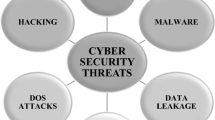Abstract
Cyber attacks hit companies, businesses, and common people every day. Cybercrime is increasing year by year as criminals that are trying to benefit from vulnerable sources. Software attacks are very difficult to detect as it hides in a very sophisticated way on the network. This survey paper gives a review of various machine learning (ML) methods used to detect different attacks. Several methods/architectures developed by researchers to detect cybercrimes using deep learning and machine learning techniques of classification are also discussed. It can be seen that machine learning and deep learning models are efficient in detecting cybercrimes with high accuracy when proper training is given.
Access this chapter
Tax calculation will be finalised at checkout
Purchases are for personal use only
Similar content being viewed by others
References
Kumar R, Zhang X, Tariq HA, Khan RU (2017) Malicious URL detection using multi-layer filtering model. In: 14th ınternational computer conference on wavelet active media technology and ınformation processing. Chengdu, pp 97–100
Dey A (2016) Machine learning algorithms: a review. Int J Comput Sci Inf Technol 7(3):1174–1179
Smys S (2019) DDoS attack detection in telecommunication network using machine learning. J Ubiquit Comput Commun Technol 01(01):33–44
He Z, Zhang T, Lee RB (2017) Machine learning based DDoS attack detection from source side in cloud. In: IEEE 4th ınternational conference on cyber security and cloud computing. New York, pp 114–120
Sadasivam GK, Hota C, Anand B (2016) Classification of SSH attacks using machine learning algorithms. In: 6th ınternational conference on IT convergence and security. Prague, pp 1–6
Laskov P, Šrndic N (2011) Static detection of malicious javascript-bearing PDF documents. In: 27th annual computer security applications conference. Orlando, pp 373–382
Najafabadi MM, Khoshgoftaar TM, Calvert C, Kemp C (2015) Detection of SSH brute force attacks using aggregated netflow data. In: IEEE 14th ınternational conference on machine learning and applications. Miami, pp 283–288
Alswailem A, Alabdullah B, Alrumayh N, Alsedrani A (2019) Detecting phishing websites using machine learning. In: 2nd ınternational conference on computer applications & ınformation security. Riyadh, Saudi Arabia, pp 1–6
Dong Z, Espejo R, Wan Zhuang YW (2015) Detecting and locating man-in-the-middle attacks in fixed wireless networks. J Comput Inf Technol, pp 283–293
Huang Y, Li L (2011) Naive Bayes classification algorithm based on small sample set. In: IEEE ınternational conference on cloud computing and ıntelligence systems. Beijing, pp 34–39
Naïve Bayes for Machine Learning, https://machinelearningmastery.com/naive-bayes-for-machine-learning/
Classification and regression, https://www.geeksforgeeks.org/ml-classification-vs-regression/
Zhong Y (2016) The analysis of cases based on decision tree. In: 7th IEEE ınternational conference on software engineering and service science. Beijing, pp 142–147
Jaiswal JK, Samikannu R (2017) Application of random forest algorithm on feature subset selection and classification and regression. In: World congress on computing and communication technologies. Tiruchirappalli, pp 65–68
Denil M, Matheson D, Nando de Freitas (2014) Narrowing the gap: random forests in theory and ın practice. In: Proceedings of the 31st ınternational conference on machine learning, vol 32 (2014)
Working of Random Forest, https://www.tutorialspoint.com/machine_learning_with_python/machine_learning_with_python_classification_algorithms_random_forest.htm
Imandoust SB, Bolandraftar M (2013) Application of K-nearest neighbor (KNN) approach for predicting economic events: theoretical background. Int J Eng Res Appl 3(5):605–610
Berman DS, Buczak AL, Chavis JS, Corbett CL (2019) A survey of deep learning methods for cyber security. MDPI
Wiese B, Omlin C (2009) Credit card transactions, fraud detection, and machine learning: modelling time with LSTM recurrent neural networks. In: Innovations in neural ınformation paradigms and applications. Studies in computational ıntelligence, vol 247. Springer, Berlin, Heidelberg, pp 231–268
LSTM, https://medium.com/@kangeugine/long-short-term-memory-lstm-concept-cb3283934359
Author information
Authors and Affiliations
Corresponding author
Editor information
Editors and Affiliations
Rights and permissions
Copyright information
© 2021 The Author(s), under exclusive license to Springer Nature Singapore Pte Ltd.
About this paper
Cite this paper
Pakhare, P.S., Krishnan, S., Charniya, N.N. (2021). A Survey on Recent Advances in Cyber Assault Detection Using Machine Learning and Deep Learning. In: Raj, J.S., Iliyasu, A.M., Bestak, R., Baig, Z.A. (eds) Innovative Data Communication Technologies and Application. Lecture Notes on Data Engineering and Communications Technologies, vol 59. Springer, Singapore. https://doi.org/10.1007/978-981-15-9651-3_47
Download citation
DOI: https://doi.org/10.1007/978-981-15-9651-3_47
Published:
Publisher Name: Springer, Singapore
Print ISBN: 978-981-15-9650-6
Online ISBN: 978-981-15-9651-3
eBook Packages: Intelligent Technologies and RoboticsIntelligent Technologies and Robotics (R0)




